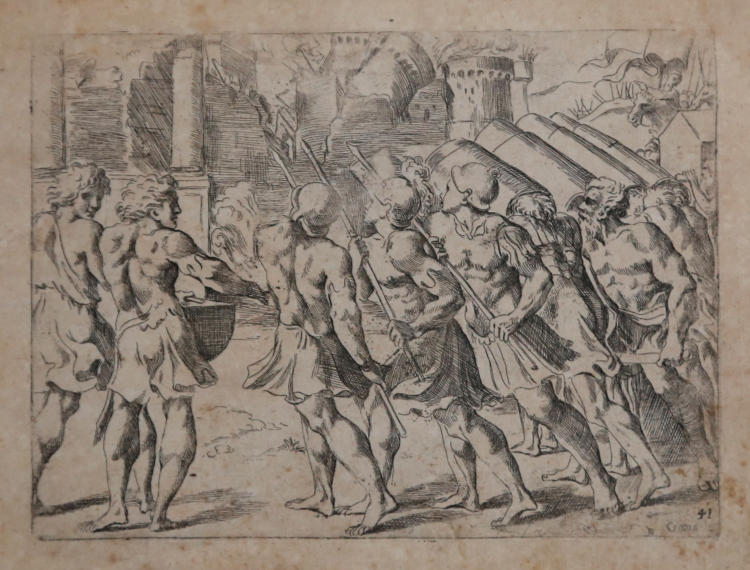



| Reference: | S39906 |
| Author | Giovanni LANFRANCO |
| Year: | 1607 |
| Measures: | 180 x 135 mm |


| Reference: | S39906 |
| Author | Giovanni LANFRANCO |
| Year: | 1607 |
| Measures: | 180 x 135 mm |
Plate of the Raphael Bible etched by Badalocchio and Lanfranco, titled Historia del Testamento Vecchio dipinta in Roma nel Vaticano da Raffaello da Urbino et intagliata in rame da Sisto Badalocchi et Giovanni Lanfranchi Parmigian. Al Sig. Annibale Carracci. In Roma appresso a Giovanni Orlandi. Con licenza de' Superiori. 1607.
The series consists of 54 plates, a frontispiece and three etched plates with dedicatory text to Annibale Carracci and 50 plates after Raphael that are numbered from 5 to 54.
The set was made when the two etchers were both young pupils of Carracci in Rome in 1607 and were said to have been made to try to lift him out of depression; 28 plates are by Lanfranco (Bartsch XVIII.345.1 to 28) and 23 (including the frontispiece) by Badalocchio (Bartsch XVIII.354.1 to 23).
From Michael Bury, The Print in Italy, BM 2001, cat.90: “The etchings reverse Raphael's compositions. Mussini noted a tendency to simplification and alteration, especially in Badalocchio (Mussini, 1979, p.61); Borea suggested that the prints are the result of some critical reflection (1986, p.xvi). In the plate shown here, the spatial structure is substantially altered by cutting the height of the scene, making Isaac's head almost touch the top edge. This is in line with what is done in many others, by Sisto Badalocchio as well as Lanfranco. The effect is to increase the size and impact of the figures, for it is their movements and their relationships with one another that are at the centre of attention.
The long dedication to Annibale Carracci reveals that the drawings had been made during the previous summer, while the Pope was away from the Vatican. Annibale's illness had prevented Badalocchio and Lanfranco from studying with him, and, keen to pursue their studies during this period, they had turned to the work of Raphael, whom Annibale always praised so much. They had now decided to publish their drawings for the benefit of young students of painting who live far away, executing them in etching 'for greater speed' ("per maggiore prestezza"). It is pointed out that not everyone has appreciated the Loggie frescoes as much as they deserve, believing them to have only been designed by Raphael; however for the variety of the inventions and for their sublime subjects they are worthy of the highest regard. Ginzburg Carignani (1996, p.130 and n.112) has shown that the preface was not in fact written by the two pupils, but by G.B.Agucchi (1570-1632) the patron and writer on art. Agucchi was a great champion of the Carracci and of Annibale in particular, seeing them as the reformers who had restored painting to the true path marked out first by the ancients and then, in modern times, by Raphael.
Etching, printed on contemporary laid paper, with full margins showing tears at waterstains, otherwise good condition.
|
TIB.40.21
|
Giovanni LANFRANCO (Parma, 26 Gennaio 1582; Roma, 29 Novembre 1647).
|
Italian painter and draughtsman. A major figure in the development of the Roman Baroque in the 1620s, he painted many altarpieces and some cabinet pictures, but was notable above all for a number of dome frescoes that are indebted to the works of Correggio; most celebrated is the Assumption of the Virgin (1625–7) in the dome of S Andrea della Valle, Rome. He also influenced the development of art in Naples, where, between 1634 and 1646, he executed a series of vast fresco commissions that look forward to the art of Luca Giordano and Francesco Solimena. A vast number of Lanfranco’s preparatory drawings survive, the majority of which are now in the Museo e Gallerie Nazionali di Capodimonte, Naples. Broadly speaking they are of two types: small compositional sketches, either in brown pen, with or without brown wash, on white or beige fine paper, or in red chalk, sometimes with red wash, or, more rarely, in black chalk or a combination of both red and black; and slightly larger figure studies, drawn after the live model, in black and white chalk on rough, coloured (beige, green, grey or bluish) paper.
|
|
TIB.40.21
|
Giovanni LANFRANCO (Parma, 26 Gennaio 1582; Roma, 29 Novembre 1647).
|
Italian painter and draughtsman. A major figure in the development of the Roman Baroque in the 1620s, he painted many altarpieces and some cabinet pictures, but was notable above all for a number of dome frescoes that are indebted to the works of Correggio; most celebrated is the Assumption of the Virgin (1625–7) in the dome of S Andrea della Valle, Rome. He also influenced the development of art in Naples, where, between 1634 and 1646, he executed a series of vast fresco commissions that look forward to the art of Luca Giordano and Francesco Solimena. A vast number of Lanfranco’s preparatory drawings survive, the majority of which are now in the Museo e Gallerie Nazionali di Capodimonte, Naples. Broadly speaking they are of two types: small compositional sketches, either in brown pen, with or without brown wash, on white or beige fine paper, or in red chalk, sometimes with red wash, or, more rarely, in black chalk or a combination of both red and black; and slightly larger figure studies, drawn after the live model, in black and white chalk on rough, coloured (beige, green, grey or bluish) paper.
|